DBS Bank Financial Management: An Analysis of Dividend Policy
VerifiedAdded on 2023/06/14
|9
|2236
|385
Report
AI Summary
This report provides an analysis of the dividend policy of Development Bank of Singapore (DBS), focusing on the application of different dividend computation methods like the Constant Dividend Model, Constant Growth Model, and Residual Income Approach. It highlights DBS's use of the Constant Growth Model, evidenced by increasing dividend trends and a significant increase in dividends per share. The report also forecasts DBS's revenue for 2018, anticipating growth due to digital banking advancements, the acquisition of ANZ's retail and wealth franchise, and strategic partnerships. Furthermore, a reflective assessment details the learning experience gained from analyzing financial statements, understanding dividend policies, and working collaboratively on the assignment. Desklib offers a platform to explore this and more solved assignments, aiding students in their studies.
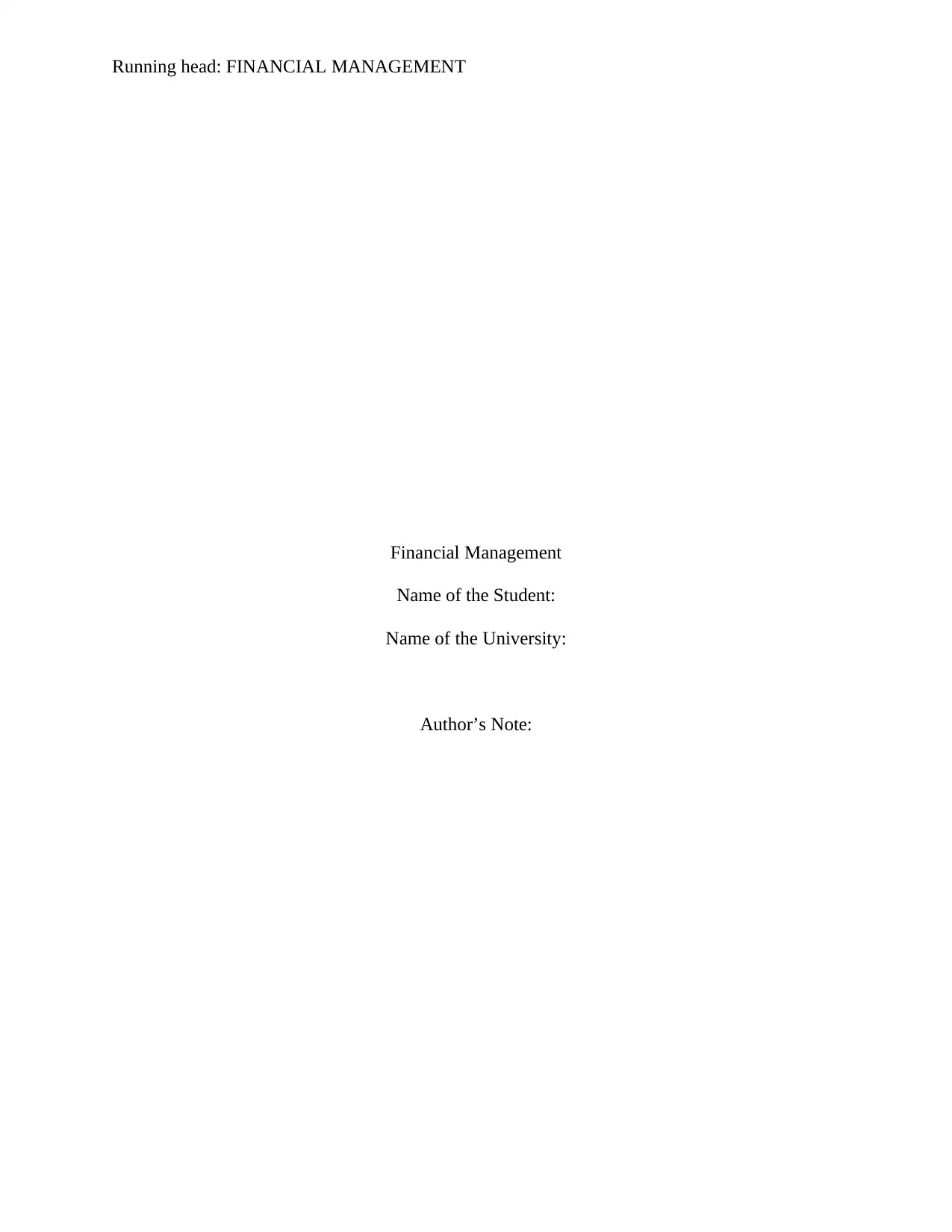
Running head: FINANCIAL MANAGEMENT
Financial Management
Name of the Student:
Name of the University:
Author’s Note:
Financial Management
Name of the Student:
Name of the University:
Author’s Note:
Paraphrase This Document
Need a fresh take? Get an instant paraphrase of this document with our AI Paraphraser
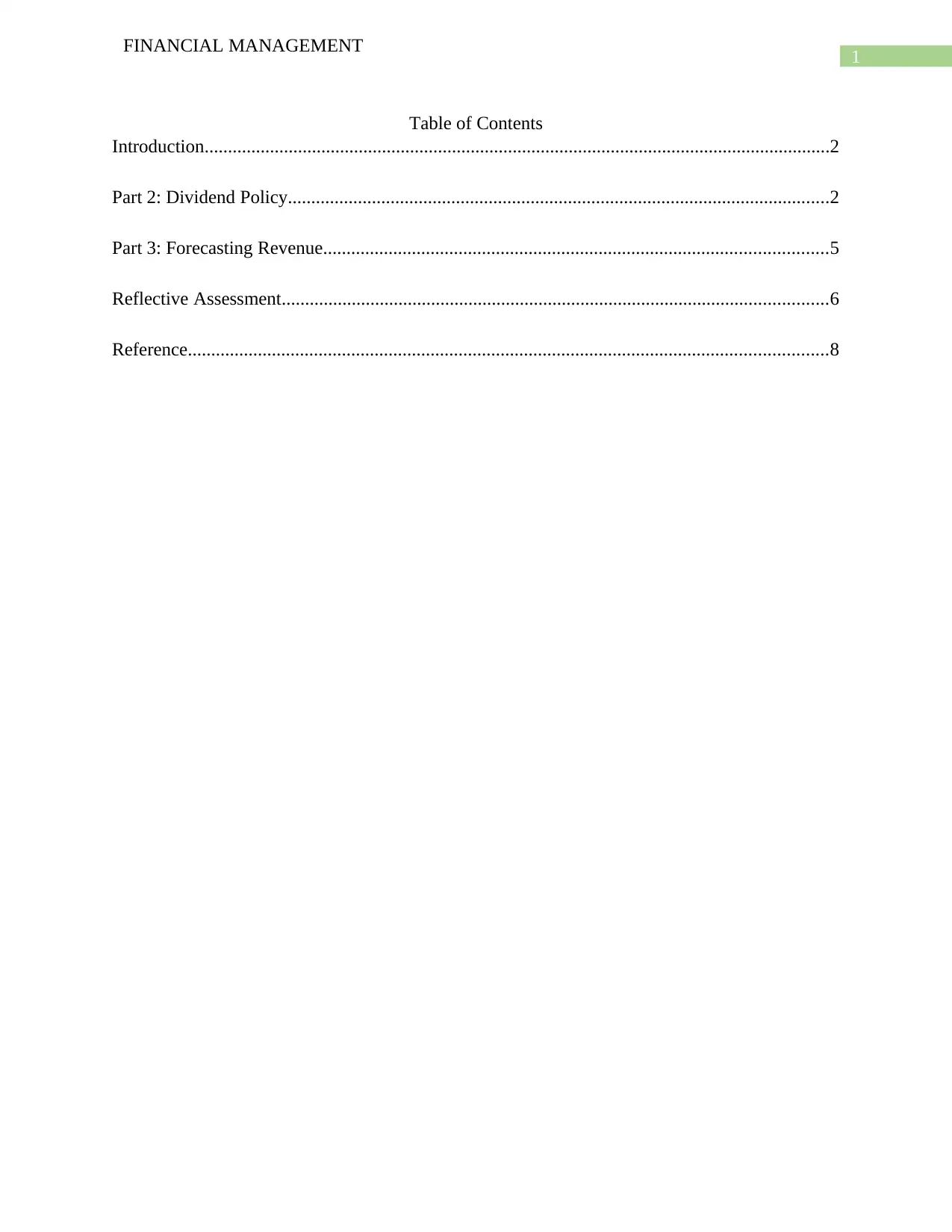
1
FINANCIAL MANAGEMENT
Table of Contents
Introduction......................................................................................................................................2
Part 2: Dividend Policy....................................................................................................................2
Part 3: Forecasting Revenue............................................................................................................5
Reflective Assessment.....................................................................................................................6
Reference.........................................................................................................................................8
FINANCIAL MANAGEMENT
Table of Contents
Introduction......................................................................................................................................2
Part 2: Dividend Policy....................................................................................................................2
Part 3: Forecasting Revenue............................................................................................................5
Reflective Assessment.....................................................................................................................6
Reference.........................................................................................................................................8
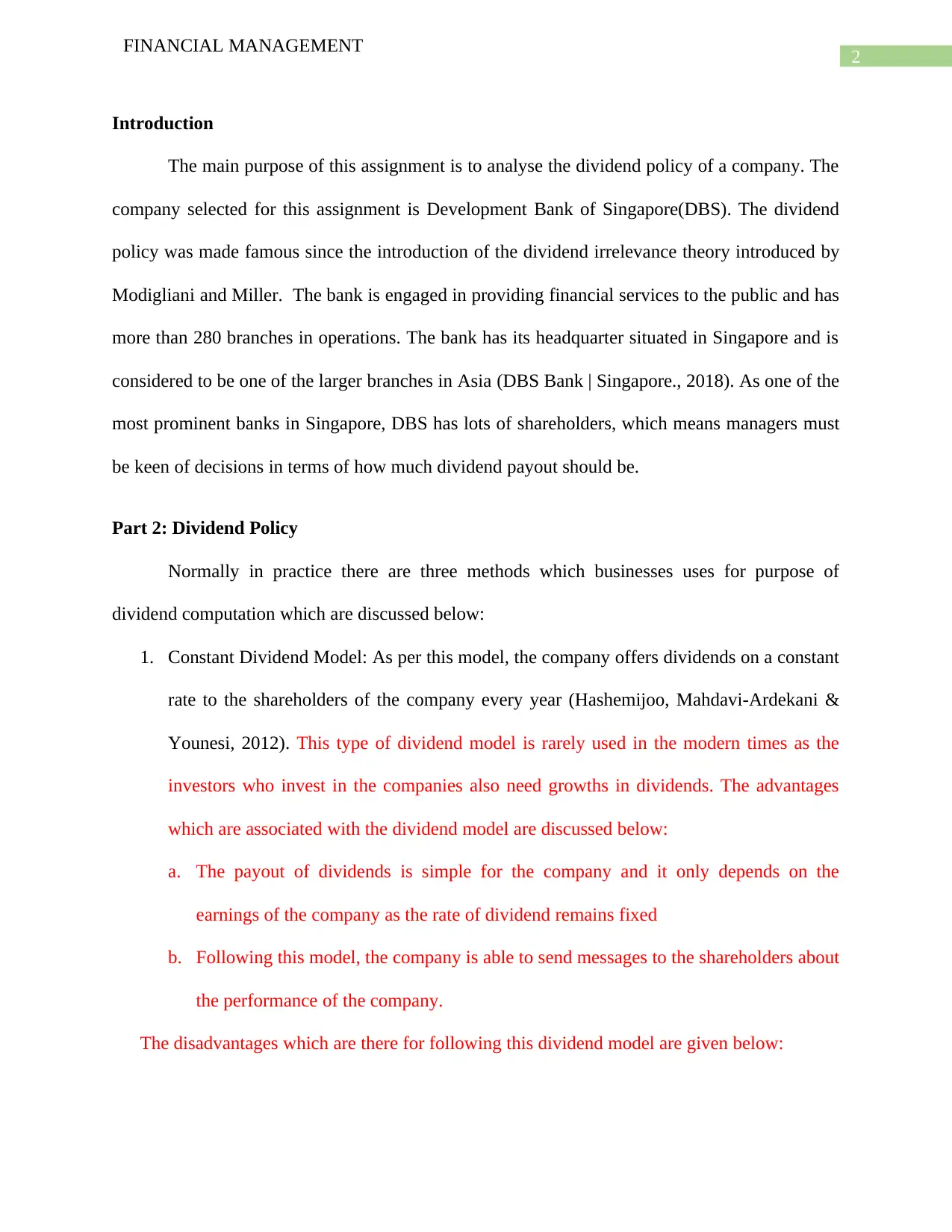
2
FINANCIAL MANAGEMENT
Introduction
The main purpose of this assignment is to analyse the dividend policy of a company. The
company selected for this assignment is Development Bank of Singapore(DBS). The dividend
policy was made famous since the introduction of the dividend irrelevance theory introduced by
Modigliani and Miller. The bank is engaged in providing financial services to the public and has
more than 280 branches in operations. The bank has its headquarter situated in Singapore and is
considered to be one of the larger branches in Asia (DBS Bank | Singapore., 2018). As one of the
most prominent banks in Singapore, DBS has lots of shareholders, which means managers must
be keen of decisions in terms of how much dividend payout should be.
Part 2: Dividend Policy
Normally in practice there are three methods which businesses uses for purpose of
dividend computation which are discussed below:
1. Constant Dividend Model: As per this model, the company offers dividends on a constant
rate to the shareholders of the company every year (Hashemijoo, Mahdavi-Ardekani &
Younesi, 2012). This type of dividend model is rarely used in the modern times as the
investors who invest in the companies also need growths in dividends. The advantages
which are associated with the dividend model are discussed below:
a. The payout of dividends is simple for the company and it only depends on the
earnings of the company as the rate of dividend remains fixed
b. Following this model, the company is able to send messages to the shareholders about
the performance of the company.
The disadvantages which are there for following this dividend model are given below:
FINANCIAL MANAGEMENT
Introduction
The main purpose of this assignment is to analyse the dividend policy of a company. The
company selected for this assignment is Development Bank of Singapore(DBS). The dividend
policy was made famous since the introduction of the dividend irrelevance theory introduced by
Modigliani and Miller. The bank is engaged in providing financial services to the public and has
more than 280 branches in operations. The bank has its headquarter situated in Singapore and is
considered to be one of the larger branches in Asia (DBS Bank | Singapore., 2018). As one of the
most prominent banks in Singapore, DBS has lots of shareholders, which means managers must
be keen of decisions in terms of how much dividend payout should be.
Part 2: Dividend Policy
Normally in practice there are three methods which businesses uses for purpose of
dividend computation which are discussed below:
1. Constant Dividend Model: As per this model, the company offers dividends on a constant
rate to the shareholders of the company every year (Hashemijoo, Mahdavi-Ardekani &
Younesi, 2012). This type of dividend model is rarely used in the modern times as the
investors who invest in the companies also need growths in dividends. The advantages
which are associated with the dividend model are discussed below:
a. The payout of dividends is simple for the company and it only depends on the
earnings of the company as the rate of dividend remains fixed
b. Following this model, the company is able to send messages to the shareholders about
the performance of the company.
The disadvantages which are there for following this dividend model are given below:
⊘ This is a preview!⊘
Do you want full access?
Subscribe today to unlock all pages.

Trusted by 1+ million students worldwide
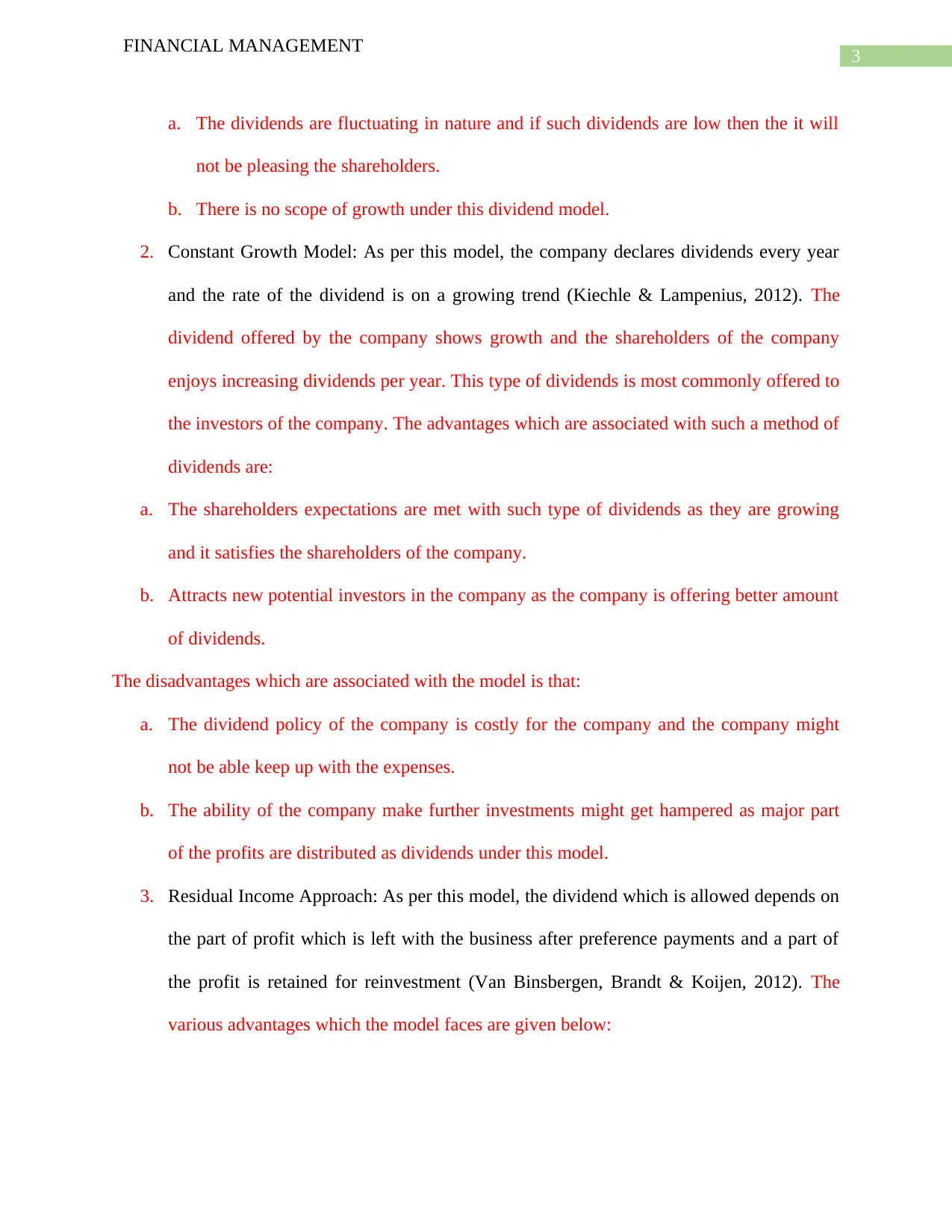
3
FINANCIAL MANAGEMENT
a. The dividends are fluctuating in nature and if such dividends are low then the it will
not be pleasing the shareholders.
b. There is no scope of growth under this dividend model.
2. Constant Growth Model: As per this model, the company declares dividends every year
and the rate of the dividend is on a growing trend (Kiechle & Lampenius, 2012). The
dividend offered by the company shows growth and the shareholders of the company
enjoys increasing dividends per year. This type of dividends is most commonly offered to
the investors of the company. The advantages which are associated with such a method of
dividends are:
a. The shareholders expectations are met with such type of dividends as they are growing
and it satisfies the shareholders of the company.
b. Attracts new potential investors in the company as the company is offering better amount
of dividends.
The disadvantages which are associated with the model is that:
a. The dividend policy of the company is costly for the company and the company might
not be able keep up with the expenses.
b. The ability of the company make further investments might get hampered as major part
of the profits are distributed as dividends under this model.
3. Residual Income Approach: As per this model, the dividend which is allowed depends on
the part of profit which is left with the business after preference payments and a part of
the profit is retained for reinvestment (Van Binsbergen, Brandt & Koijen, 2012). The
various advantages which the model faces are given below:
FINANCIAL MANAGEMENT
a. The dividends are fluctuating in nature and if such dividends are low then the it will
not be pleasing the shareholders.
b. There is no scope of growth under this dividend model.
2. Constant Growth Model: As per this model, the company declares dividends every year
and the rate of the dividend is on a growing trend (Kiechle & Lampenius, 2012). The
dividend offered by the company shows growth and the shareholders of the company
enjoys increasing dividends per year. This type of dividends is most commonly offered to
the investors of the company. The advantages which are associated with such a method of
dividends are:
a. The shareholders expectations are met with such type of dividends as they are growing
and it satisfies the shareholders of the company.
b. Attracts new potential investors in the company as the company is offering better amount
of dividends.
The disadvantages which are associated with the model is that:
a. The dividend policy of the company is costly for the company and the company might
not be able keep up with the expenses.
b. The ability of the company make further investments might get hampered as major part
of the profits are distributed as dividends under this model.
3. Residual Income Approach: As per this model, the dividend which is allowed depends on
the part of profit which is left with the business after preference payments and a part of
the profit is retained for reinvestment (Van Binsbergen, Brandt & Koijen, 2012). The
various advantages which the model faces are given below:
Paraphrase This Document
Need a fresh take? Get an instant paraphrase of this document with our AI Paraphraser
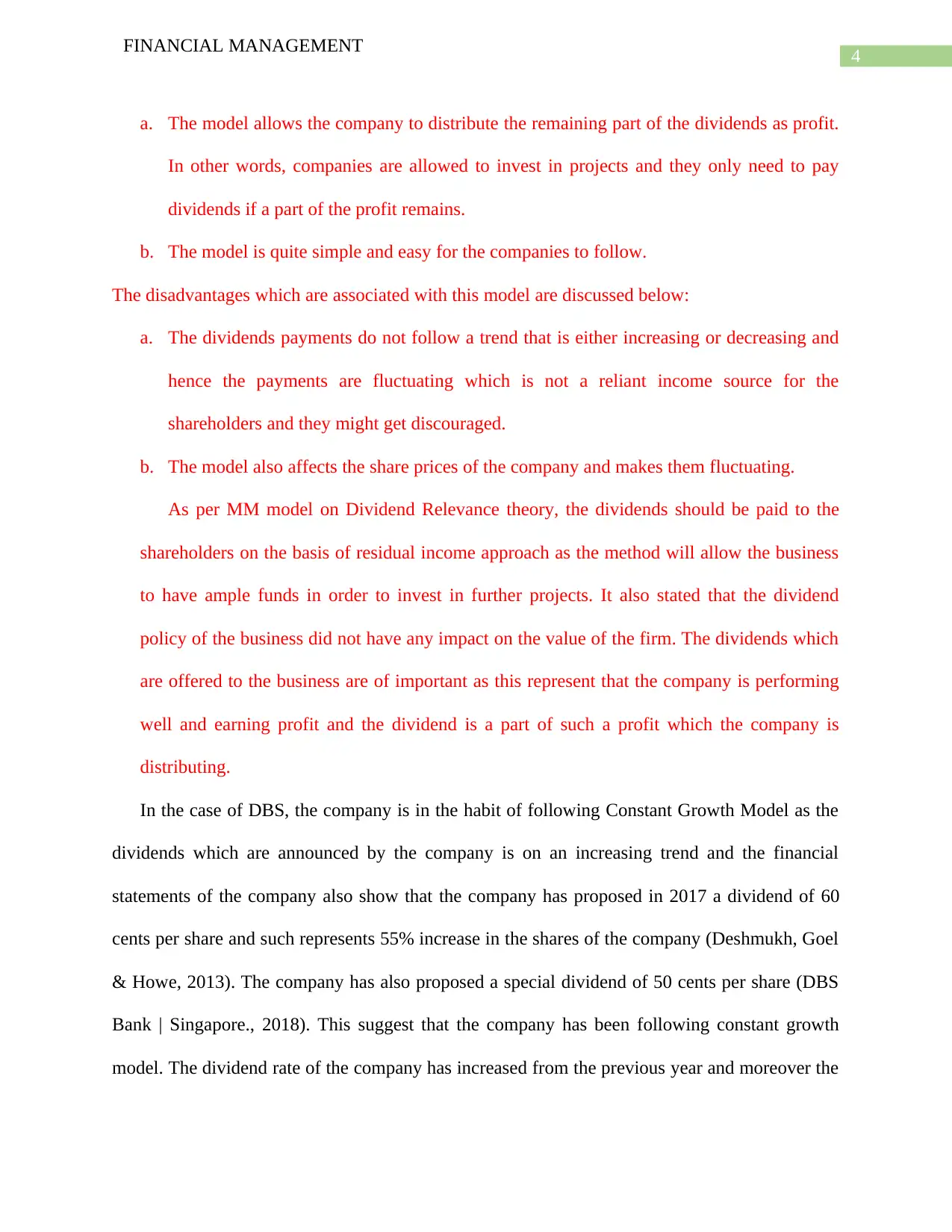
4
FINANCIAL MANAGEMENT
a. The model allows the company to distribute the remaining part of the dividends as profit.
In other words, companies are allowed to invest in projects and they only need to pay
dividends if a part of the profit remains.
b. The model is quite simple and easy for the companies to follow.
The disadvantages which are associated with this model are discussed below:
a. The dividends payments do not follow a trend that is either increasing or decreasing and
hence the payments are fluctuating which is not a reliant income source for the
shareholders and they might get discouraged.
b. The model also affects the share prices of the company and makes them fluctuating.
As per MM model on Dividend Relevance theory, the dividends should be paid to the
shareholders on the basis of residual income approach as the method will allow the business
to have ample funds in order to invest in further projects. It also stated that the dividend
policy of the business did not have any impact on the value of the firm. The dividends which
are offered to the business are of important as this represent that the company is performing
well and earning profit and the dividend is a part of such a profit which the company is
distributing.
In the case of DBS, the company is in the habit of following Constant Growth Model as the
dividends which are announced by the company is on an increasing trend and the financial
statements of the company also show that the company has proposed in 2017 a dividend of 60
cents per share and such represents 55% increase in the shares of the company (Deshmukh, Goel
& Howe, 2013). The company has also proposed a special dividend of 50 cents per share (DBS
Bank | Singapore., 2018). This suggest that the company has been following constant growth
model. The dividend rate of the company has increased from the previous year and moreover the
FINANCIAL MANAGEMENT
a. The model allows the company to distribute the remaining part of the dividends as profit.
In other words, companies are allowed to invest in projects and they only need to pay
dividends if a part of the profit remains.
b. The model is quite simple and easy for the companies to follow.
The disadvantages which are associated with this model are discussed below:
a. The dividends payments do not follow a trend that is either increasing or decreasing and
hence the payments are fluctuating which is not a reliant income source for the
shareholders and they might get discouraged.
b. The model also affects the share prices of the company and makes them fluctuating.
As per MM model on Dividend Relevance theory, the dividends should be paid to the
shareholders on the basis of residual income approach as the method will allow the business
to have ample funds in order to invest in further projects. It also stated that the dividend
policy of the business did not have any impact on the value of the firm. The dividends which
are offered to the business are of important as this represent that the company is performing
well and earning profit and the dividend is a part of such a profit which the company is
distributing.
In the case of DBS, the company is in the habit of following Constant Growth Model as the
dividends which are announced by the company is on an increasing trend and the financial
statements of the company also show that the company has proposed in 2017 a dividend of 60
cents per share and such represents 55% increase in the shares of the company (Deshmukh, Goel
& Howe, 2013). The company has also proposed a special dividend of 50 cents per share (DBS
Bank | Singapore., 2018). This suggest that the company has been following constant growth
model. The dividend rate of the company has increased from the previous year and moreover the
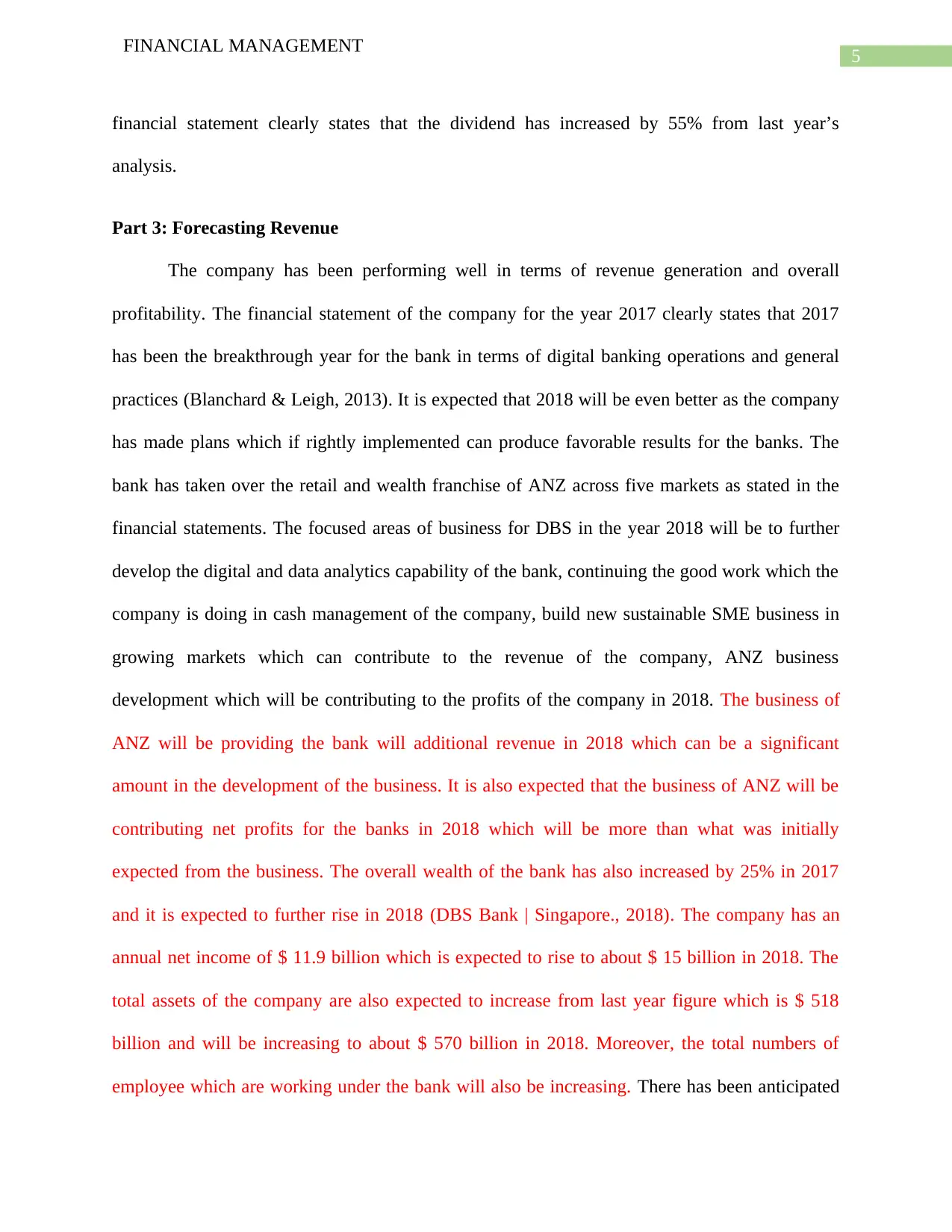
5
FINANCIAL MANAGEMENT
financial statement clearly states that the dividend has increased by 55% from last year’s
analysis.
Part 3: Forecasting Revenue
The company has been performing well in terms of revenue generation and overall
profitability. The financial statement of the company for the year 2017 clearly states that 2017
has been the breakthrough year for the bank in terms of digital banking operations and general
practices (Blanchard & Leigh, 2013). It is expected that 2018 will be even better as the company
has made plans which if rightly implemented can produce favorable results for the banks. The
bank has taken over the retail and wealth franchise of ANZ across five markets as stated in the
financial statements. The focused areas of business for DBS in the year 2018 will be to further
develop the digital and data analytics capability of the bank, continuing the good work which the
company is doing in cash management of the company, build new sustainable SME business in
growing markets which can contribute to the revenue of the company, ANZ business
development which will be contributing to the profits of the company in 2018. The business of
ANZ will be providing the bank will additional revenue in 2018 which can be a significant
amount in the development of the business. It is also expected that the business of ANZ will be
contributing net profits for the banks in 2018 which will be more than what was initially
expected from the business. The overall wealth of the bank has also increased by 25% in 2017
and it is expected to further rise in 2018 (DBS Bank | Singapore., 2018). The company has an
annual net income of $ 11.9 billion which is expected to rise to about $ 15 billion in 2018. The
total assets of the company are also expected to increase from last year figure which is $ 518
billion and will be increasing to about $ 570 billion in 2018. Moreover, the total numbers of
employee which are working under the bank will also be increasing. There has been anticipated
FINANCIAL MANAGEMENT
financial statement clearly states that the dividend has increased by 55% from last year’s
analysis.
Part 3: Forecasting Revenue
The company has been performing well in terms of revenue generation and overall
profitability. The financial statement of the company for the year 2017 clearly states that 2017
has been the breakthrough year for the bank in terms of digital banking operations and general
practices (Blanchard & Leigh, 2013). It is expected that 2018 will be even better as the company
has made plans which if rightly implemented can produce favorable results for the banks. The
bank has taken over the retail and wealth franchise of ANZ across five markets as stated in the
financial statements. The focused areas of business for DBS in the year 2018 will be to further
develop the digital and data analytics capability of the bank, continuing the good work which the
company is doing in cash management of the company, build new sustainable SME business in
growing markets which can contribute to the revenue of the company, ANZ business
development which will be contributing to the profits of the company in 2018. The business of
ANZ will be providing the bank will additional revenue in 2018 which can be a significant
amount in the development of the business. It is also expected that the business of ANZ will be
contributing net profits for the banks in 2018 which will be more than what was initially
expected from the business. The overall wealth of the bank has also increased by 25% in 2017
and it is expected to further rise in 2018 (DBS Bank | Singapore., 2018). The company has an
annual net income of $ 11.9 billion which is expected to rise to about $ 15 billion in 2018. The
total assets of the company are also expected to increase from last year figure which is $ 518
billion and will be increasing to about $ 570 billion in 2018. Moreover, the total numbers of
employee which are working under the bank will also be increasing. There has been anticipated
⊘ This is a preview!⊘
Do you want full access?
Subscribe today to unlock all pages.

Trusted by 1+ million students worldwide
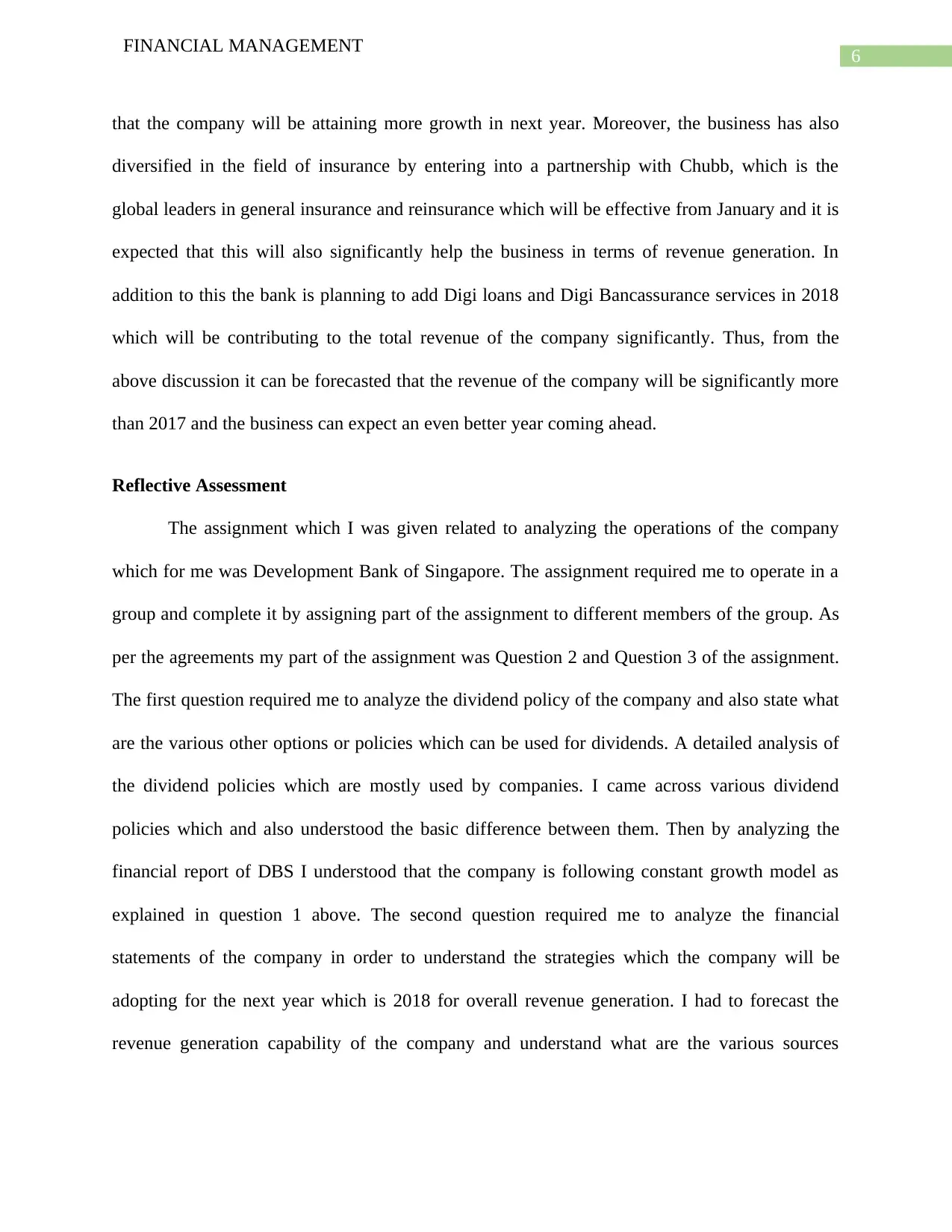
6
FINANCIAL MANAGEMENT
that the company will be attaining more growth in next year. Moreover, the business has also
diversified in the field of insurance by entering into a partnership with Chubb, which is the
global leaders in general insurance and reinsurance which will be effective from January and it is
expected that this will also significantly help the business in terms of revenue generation. In
addition to this the bank is planning to add Digi loans and Digi Bancassurance services in 2018
which will be contributing to the total revenue of the company significantly. Thus, from the
above discussion it can be forecasted that the revenue of the company will be significantly more
than 2017 and the business can expect an even better year coming ahead.
Reflective Assessment
The assignment which I was given related to analyzing the operations of the company
which for me was Development Bank of Singapore. The assignment required me to operate in a
group and complete it by assigning part of the assignment to different members of the group. As
per the agreements my part of the assignment was Question 2 and Question 3 of the assignment.
The first question required me to analyze the dividend policy of the company and also state what
are the various other options or policies which can be used for dividends. A detailed analysis of
the dividend policies which are mostly used by companies. I came across various dividend
policies which and also understood the basic difference between them. Then by analyzing the
financial report of DBS I understood that the company is following constant growth model as
explained in question 1 above. The second question required me to analyze the financial
statements of the company in order to understand the strategies which the company will be
adopting for the next year which is 2018 for overall revenue generation. I had to forecast the
revenue generation capability of the company and understand what are the various sources
FINANCIAL MANAGEMENT
that the company will be attaining more growth in next year. Moreover, the business has also
diversified in the field of insurance by entering into a partnership with Chubb, which is the
global leaders in general insurance and reinsurance which will be effective from January and it is
expected that this will also significantly help the business in terms of revenue generation. In
addition to this the bank is planning to add Digi loans and Digi Bancassurance services in 2018
which will be contributing to the total revenue of the company significantly. Thus, from the
above discussion it can be forecasted that the revenue of the company will be significantly more
than 2017 and the business can expect an even better year coming ahead.
Reflective Assessment
The assignment which I was given related to analyzing the operations of the company
which for me was Development Bank of Singapore. The assignment required me to operate in a
group and complete it by assigning part of the assignment to different members of the group. As
per the agreements my part of the assignment was Question 2 and Question 3 of the assignment.
The first question required me to analyze the dividend policy of the company and also state what
are the various other options or policies which can be used for dividends. A detailed analysis of
the dividend policies which are mostly used by companies. I came across various dividend
policies which and also understood the basic difference between them. Then by analyzing the
financial report of DBS I understood that the company is following constant growth model as
explained in question 1 above. The second question required me to analyze the financial
statements of the company in order to understand the strategies which the company will be
adopting for the next year which is 2018 for overall revenue generation. I had to forecast the
revenue generation capability of the company and understand what are the various sources
Paraphrase This Document
Need a fresh take? Get an instant paraphrase of this document with our AI Paraphraser
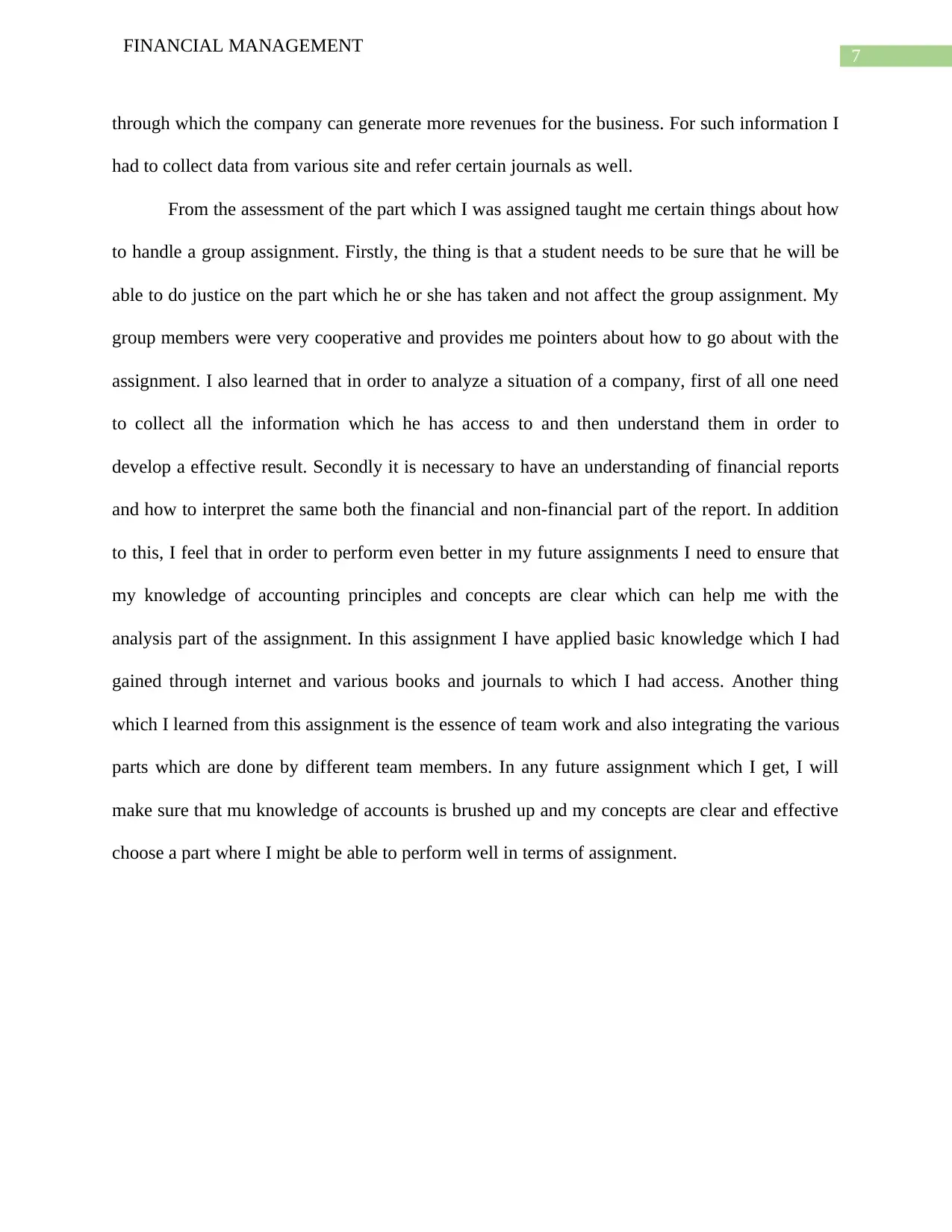
7
FINANCIAL MANAGEMENT
through which the company can generate more revenues for the business. For such information I
had to collect data from various site and refer certain journals as well.
From the assessment of the part which I was assigned taught me certain things about how
to handle a group assignment. Firstly, the thing is that a student needs to be sure that he will be
able to do justice on the part which he or she has taken and not affect the group assignment. My
group members were very cooperative and provides me pointers about how to go about with the
assignment. I also learned that in order to analyze a situation of a company, first of all one need
to collect all the information which he has access to and then understand them in order to
develop a effective result. Secondly it is necessary to have an understanding of financial reports
and how to interpret the same both the financial and non-financial part of the report. In addition
to this, I feel that in order to perform even better in my future assignments I need to ensure that
my knowledge of accounting principles and concepts are clear which can help me with the
analysis part of the assignment. In this assignment I have applied basic knowledge which I had
gained through internet and various books and journals to which I had access. Another thing
which I learned from this assignment is the essence of team work and also integrating the various
parts which are done by different team members. In any future assignment which I get, I will
make sure that mu knowledge of accounts is brushed up and my concepts are clear and effective
choose a part where I might be able to perform well in terms of assignment.
FINANCIAL MANAGEMENT
through which the company can generate more revenues for the business. For such information I
had to collect data from various site and refer certain journals as well.
From the assessment of the part which I was assigned taught me certain things about how
to handle a group assignment. Firstly, the thing is that a student needs to be sure that he will be
able to do justice on the part which he or she has taken and not affect the group assignment. My
group members were very cooperative and provides me pointers about how to go about with the
assignment. I also learned that in order to analyze a situation of a company, first of all one need
to collect all the information which he has access to and then understand them in order to
develop a effective result. Secondly it is necessary to have an understanding of financial reports
and how to interpret the same both the financial and non-financial part of the report. In addition
to this, I feel that in order to perform even better in my future assignments I need to ensure that
my knowledge of accounting principles and concepts are clear which can help me with the
analysis part of the assignment. In this assignment I have applied basic knowledge which I had
gained through internet and various books and journals to which I had access. Another thing
which I learned from this assignment is the essence of team work and also integrating the various
parts which are done by different team members. In any future assignment which I get, I will
make sure that mu knowledge of accounts is brushed up and my concepts are clear and effective
choose a part where I might be able to perform well in terms of assignment.
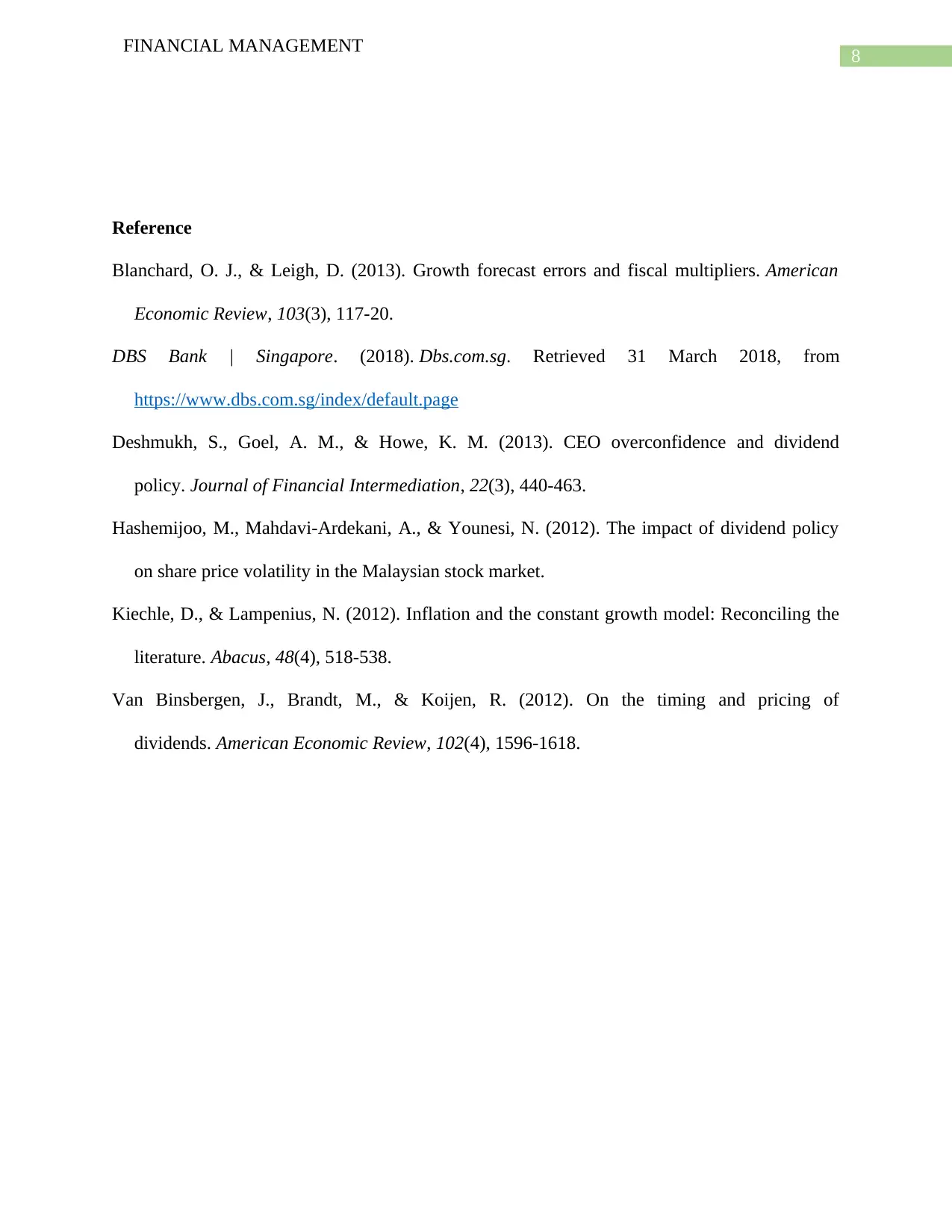
8
FINANCIAL MANAGEMENT
Reference
Blanchard, O. J., & Leigh, D. (2013). Growth forecast errors and fiscal multipliers. American
Economic Review, 103(3), 117-20.
DBS Bank | Singapore. (2018). Dbs.com.sg. Retrieved 31 March 2018, from
https://www.dbs.com.sg/index/default.page
Deshmukh, S., Goel, A. M., & Howe, K. M. (2013). CEO overconfidence and dividend
policy. Journal of Financial Intermediation, 22(3), 440-463.
Hashemijoo, M., Mahdavi-Ardekani, A., & Younesi, N. (2012). The impact of dividend policy
on share price volatility in the Malaysian stock market.
Kiechle, D., & Lampenius, N. (2012). Inflation and the constant growth model: Reconciling the
literature. Abacus, 48(4), 518-538.
Van Binsbergen, J., Brandt, M., & Koijen, R. (2012). On the timing and pricing of
dividends. American Economic Review, 102(4), 1596-1618.
FINANCIAL MANAGEMENT
Reference
Blanchard, O. J., & Leigh, D. (2013). Growth forecast errors and fiscal multipliers. American
Economic Review, 103(3), 117-20.
DBS Bank | Singapore. (2018). Dbs.com.sg. Retrieved 31 March 2018, from
https://www.dbs.com.sg/index/default.page
Deshmukh, S., Goel, A. M., & Howe, K. M. (2013). CEO overconfidence and dividend
policy. Journal of Financial Intermediation, 22(3), 440-463.
Hashemijoo, M., Mahdavi-Ardekani, A., & Younesi, N. (2012). The impact of dividend policy
on share price volatility in the Malaysian stock market.
Kiechle, D., & Lampenius, N. (2012). Inflation and the constant growth model: Reconciling the
literature. Abacus, 48(4), 518-538.
Van Binsbergen, J., Brandt, M., & Koijen, R. (2012). On the timing and pricing of
dividends. American Economic Review, 102(4), 1596-1618.
⊘ This is a preview!⊘
Do you want full access?
Subscribe today to unlock all pages.

Trusted by 1+ million students worldwide
1 out of 9
Related Documents
Your All-in-One AI-Powered Toolkit for Academic Success.
+13062052269
info@desklib.com
Available 24*7 on WhatsApp / Email
![[object Object]](/_next/static/media/star-bottom.7253800d.svg)
Unlock your academic potential
Copyright © 2020–2025 A2Z Services. All Rights Reserved. Developed and managed by ZUCOL.




